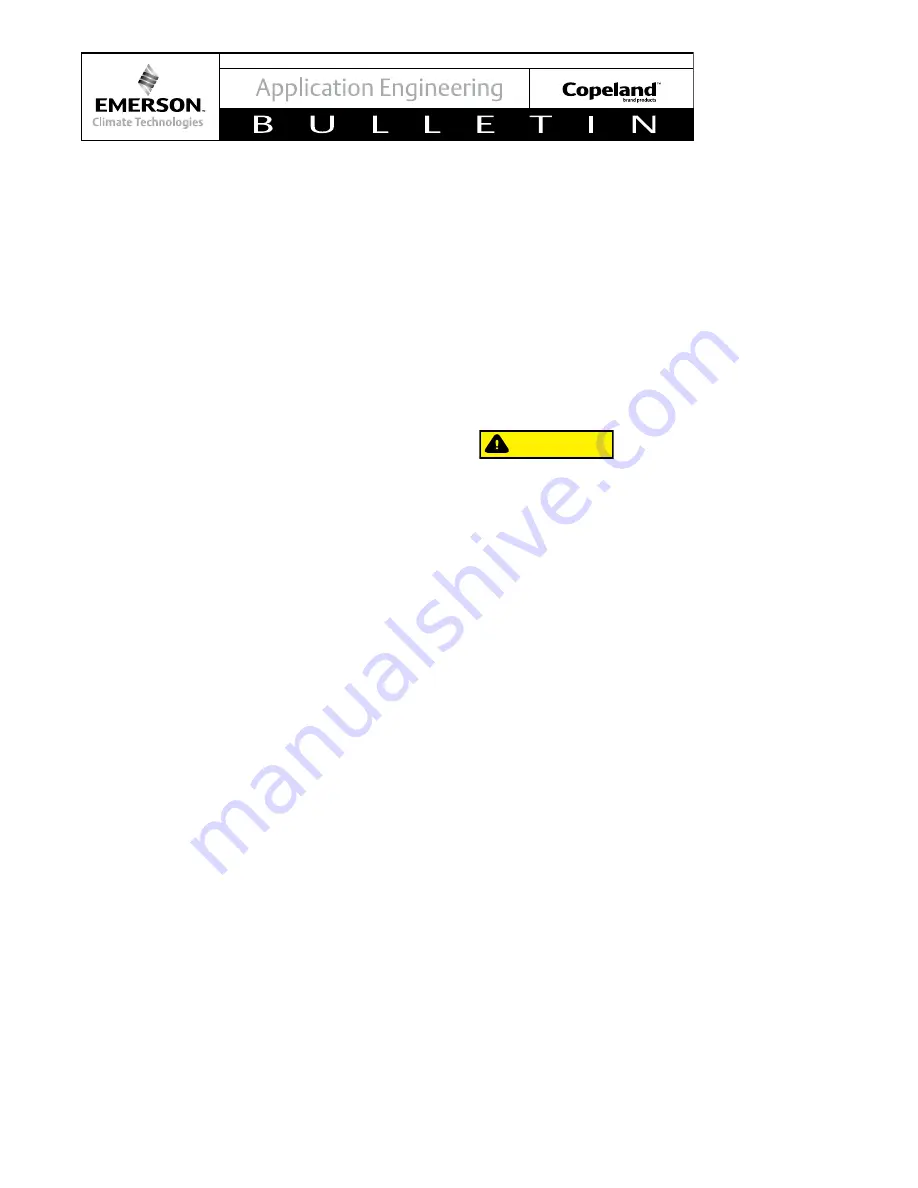
14
© 2016 Emerson Climate Technologies, Inc.
AE4-1303 R15
Assembly Line System Charging Procedure
Systems should be charged with liquid on the high side
to the extent possible. The majority of the charge should
be pumped in the high side of the system to prevent low
voltage starting difficulties, hipot failures, and bearing
washout during the first-time start on the assembly line.
If additional charge is needed, it should be added as
liquid
to the low side of the system with the compressor
operating. Pre-charging on the high side and adding
liquid on the low side of the system are both meant to
protect the compressor from operating with abnormally
low suction pressures during charging.
NOTICE
Do not
operate the compressor without enough system
charge to maintain at least 55 psig (3.8 bar) suction
pressure for R-410A and 20 psig (1.4 bar) for R-22
& R-407C. Do not operate the compressor with the
low pressure cut-out disabled. Do not operate with
a restricted suction or liquid line.
Do not use the
compressor to test the opening set point of a high
pressure cutout.
Bearings are susceptible to damage
before they have had several hours of normal running
for proper break in.
Electrical Connections
The orientation of the electrical connections on the
Copeland Scroll
™
compressors is shown in
Figure 3
and is also shown on the wiring diagram inside the
terminal box cover. The T-block screw terminals used
on this compressor should be fastened with a torque of
21 to 25 in-lb (2.37 to 2.82 Nm).
A molded plug electrical option is available for
compressors with internal overload protection (TF
electrical code) and is noted by a 1XX series bill of
material (i.e. ZP120KCE-TFD-130). The terminal cover
must be installed after the molded plug is installed to
help keep the plug in place.
WARNING! The molded electrical plug should be
installed by hand to properly seat the plug on the
electrical terminals. The plug should not be struck
with a hammer or any other device.
The terminal boxes used on compressors with TW*/
TE*
electrical codes are larger because of the motor
overload module that is housed inside of the terminal
box. These terminal boxes also have a higher ingress
protection (IP) rating. Every effort should be made to
keep the terminal box completely sealed. Oversized
conduits, poor conduit connections to the terminal box,
an incorrectly installed terminal box cover or a missing
terminal box cover gasket are a few possible air leakage
paths.
CAUTION! Moisture from warm, moist air that
is permitted to freely enter the terminal box can
condense into droplets of water inside the cooler
terminal box of the compressor. To alleviate this
problem, the warm, moist air must be prevented
from entering the terminal box. Sealing conduits
and eliminating other air leakage paths must be
taken. Dow Corning 3165 RTV is ideally suited for
sealing around wires in a conduit at the compressor
terminal box. Drilling a hole in the bottom of the
terminal box to allow the moisture to escape is not
acceptable.
“Hipot” (AC High Potential) Testing)
CAUTION
Use caution with high voltage and never hipot
when compressor is in a vacuum.
Copeland Scroll compressors are configured with the
motor down and the pumping components at the top
of the shell. As a result, the motor can be immersed
in refrigerant to a greater extent than hermetic
reciprocating compressors when liquid refrigerant is
present in the shell. In this respect, the scroll is more like
semi-hermetic compressors which can have horizontal
motors partially submerged in oil and refrigerant. When
Copeland Scroll compressors are hipot tested with liquid
refrigerant in the shell, they can show higher levels of
leakage current than compressors with the motor on top.
This phenomenon can occur with any compressor when
the motor is immersed in refrigerant. The level of current
leakage does not present any safety issue. To lower the
current leakage reading, the system should be operated
for a brief period of time to redistribute the refrigerant
to a more normal configuration and the system hipot
tested again. See
AE4-1294
for Megohm testing
recommendations.
Under no circumstances should
the hipot test be performed while the compressor
is under a vacuum.
Tandem Assembly
The first step in the tandem assembly process is to
securely mount both compressors to the rails using the
appropriate mounting hardware. After both compressors
are mounted to the rails, the suction and discharge
manifolds can be brazed to the appropriate stub tubes
on each compressor using standard brazing practices
with a nitrogen purge. See
Figure 9
for a picture of
a typical tandem assembly. Special consideration















































